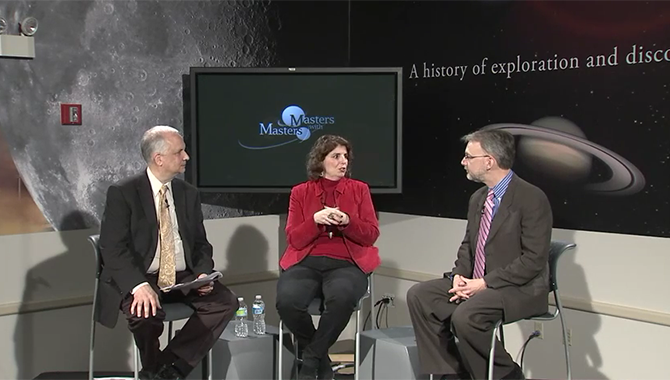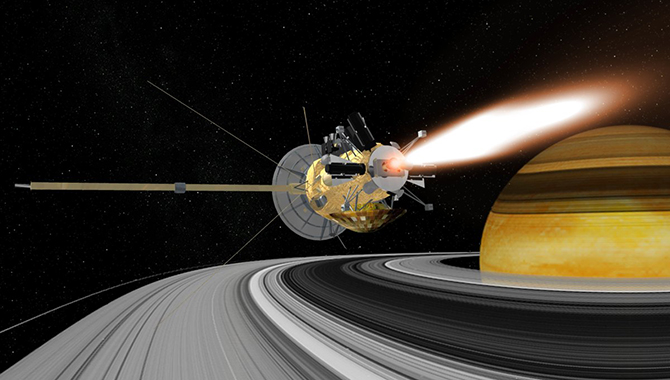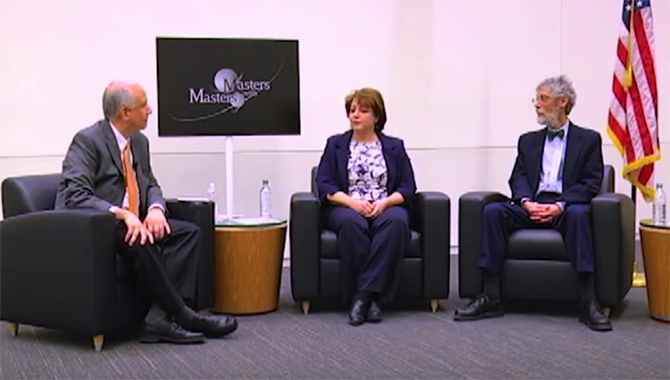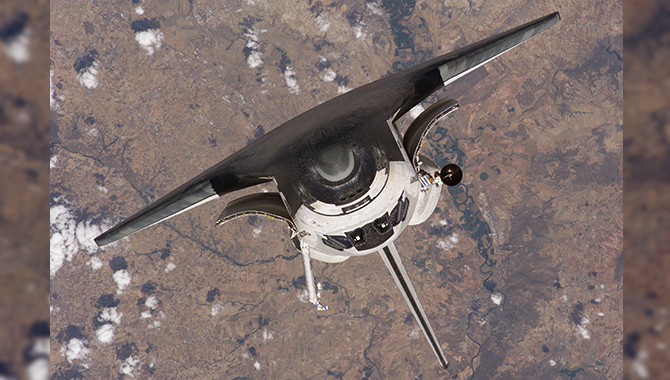
Mythbuster Jamie Hyneman poses with the NASA Innovative Advanced Concepts (NIAC) program staff at the 2014 Symposium held February 4-6 at Stanford University. From left to right: Katherine Reilly, Communications & Outreach Manager; Jamie Hyneman; Jay Falker, Program Executive; Ronald Turner, Senior Science Advisor; Jason E. Derleth, Program Manager.
Photo Credit: MASA Ames Research Center.
Mythbusters is no stranger to NASA.
The Discovery Channel’s 12-year-old TV show sets out to “bust myths”—not myths concerning Aphrodite or Zeus, but myths as in urban legends, old wives’ tales, viral YouTube videos, actions sequences from Sandra Bullock movies, etc. On the show, two teams of former Hollywood special effect wizards design experiments to “confirm” or “bust” the veracity in actuality of said myths.
Sometimes they assign a “plausible” to a tested myth. Other times, they will re-visit a myth, approaching it from a different angle, and overrule their former conclusion.
The main point of the show, at its heart of hearts, is to make science exciting, not exhaustingly exacting, though they do take themselves seriously, especially while blowing things up. And although the experiments are made to be repeatable, like all good science experiments are supposed to be, the team regularly tells their viewers “not to try this at home” since they are “experts” in their performance.
In order to test many of myths, they seek out experts in other fields, who often have access to equipment that they do not. They’ve work closely with agencies like the FBI and NASA. The show is taped in San Francisco Bay Area, so the Mythbusters have several times visited NASA’s Ames Research Center (ARC) in Mountain View, California. One of the more serious myths they tested utilized the wind tunnels at ARC: Is it better to open all the windows or to keep them shut when being hit by a tornado?
From their experiments, Mythbusters claimed that it is better to shut the windows during a high-wind weather event, if only to avoid debris flying into your house or wind damaging items already inside. Federal agencies, such as NOAA, also state that people should leave windows closed, so Mythbusters is pushing forward a best practice for dealing with high winds. While most episodes don’t offer a survival skill, most demonstrate what the independent and dependent variables are, essential to the scientific method.
Recently, while talking about Scott Kelly’s one-year trip in outer space, NASA Administrator Charlie Bolden shared, “Scott’s brother Mark is an identical twin and also an astronaut, who will be here on Earth. We’ll compare the brothers’ vital signs and learn how space affects the human body in orbit.” Bolden continues, “Throughout Scott’s mission we’ll gain new, detailed insights on ways long-duration spaceflight can affect things like bone density, muscle mass, strength, vision and other aspects of human physiology.”
It is through comparison that we gain knowledge. We perceive this from the beginning. Dark/Light. Silence/Sound. We make value judgments as we go. Good/Bad. Best/Worst.
Last month, NASA’s Academy of Program/Project and Engineering Leadership (APPEL) was recognized as the “Best Academy in the World” in project management training by Human Systems International (HSI), a division of the Project Management Institute (PMI). HSI conducted a rigorous audit of benchmarks, including many comparisons in knowledge management and curriculum content. All of NASA, of course, has reasons to be proud for this “best” superlative. And NASA has never been known to rest on their laurels. We will continue to innovate, to perform analyses and tests, to build on what we know (or do best), venture into what is unknown, and deal with what may come.
We must leverage what we know right now against the unknowable right now, the plausible.
In a recent Masters with Masters video interview with Glenn Research Center’s Michael Barrett and Diane Malarik, Barrett and Malarik stressed the importance of going forward in the realm of “imperfect knowledge” or the plausible. Barrett complimented his co-worker on how she would listen to all concerns of the team and then go forward managing risk: “So Diane multiple times would go, ‘Look, if I’ve got a solution where I think I’m 80 percent right, then I’m good. I’m ready to move. And the 20 percent of the time that it’s wrong, (then) that’s what we’ll deal with’… to make the decision and move on, as opposed to trying to get to that 95-97 percent answer.”
On Fail/Succeed, Bolden has conveyed his thoughts on Technical Authority: “If we fail—it won’t be because concerns were not heard or we were not informed, but because we collectively contemplated the risk of a particular matter, were comfortable with it, and decided that the risks were worth taking.”
Team members on Mythbusters often mention their fans while designing and performing their experiments. They will look at the camera and say something like, ‘Fans will probably write in, asking us why we did it this way… ” But, like NASA, the Mythbusters recognize other concerns and recognize when the risks are worth taking. “Do or do not,” says Yoda, “there is no try.” And, after making that decision to do, between knowing and not knowing, there is no comparison.









